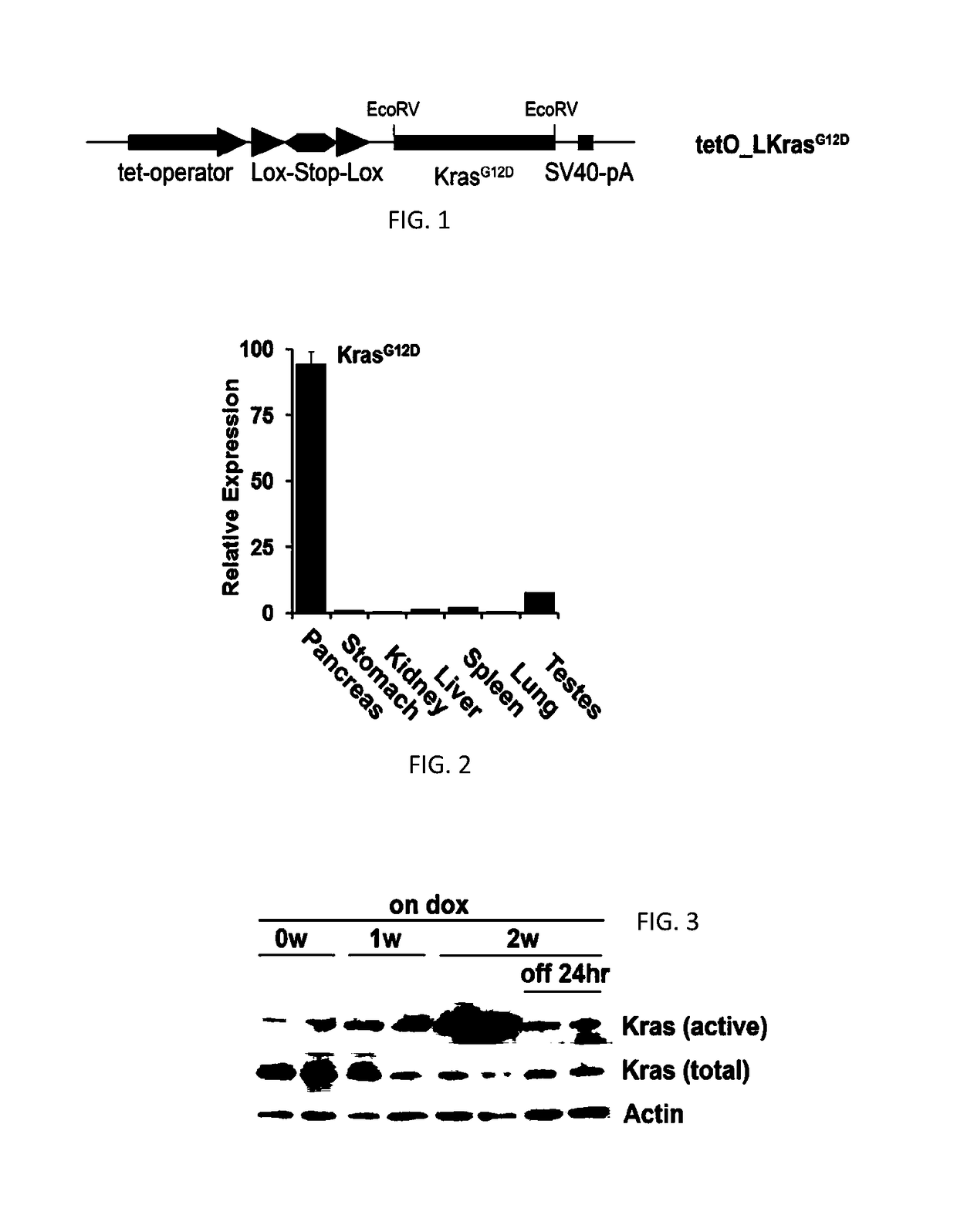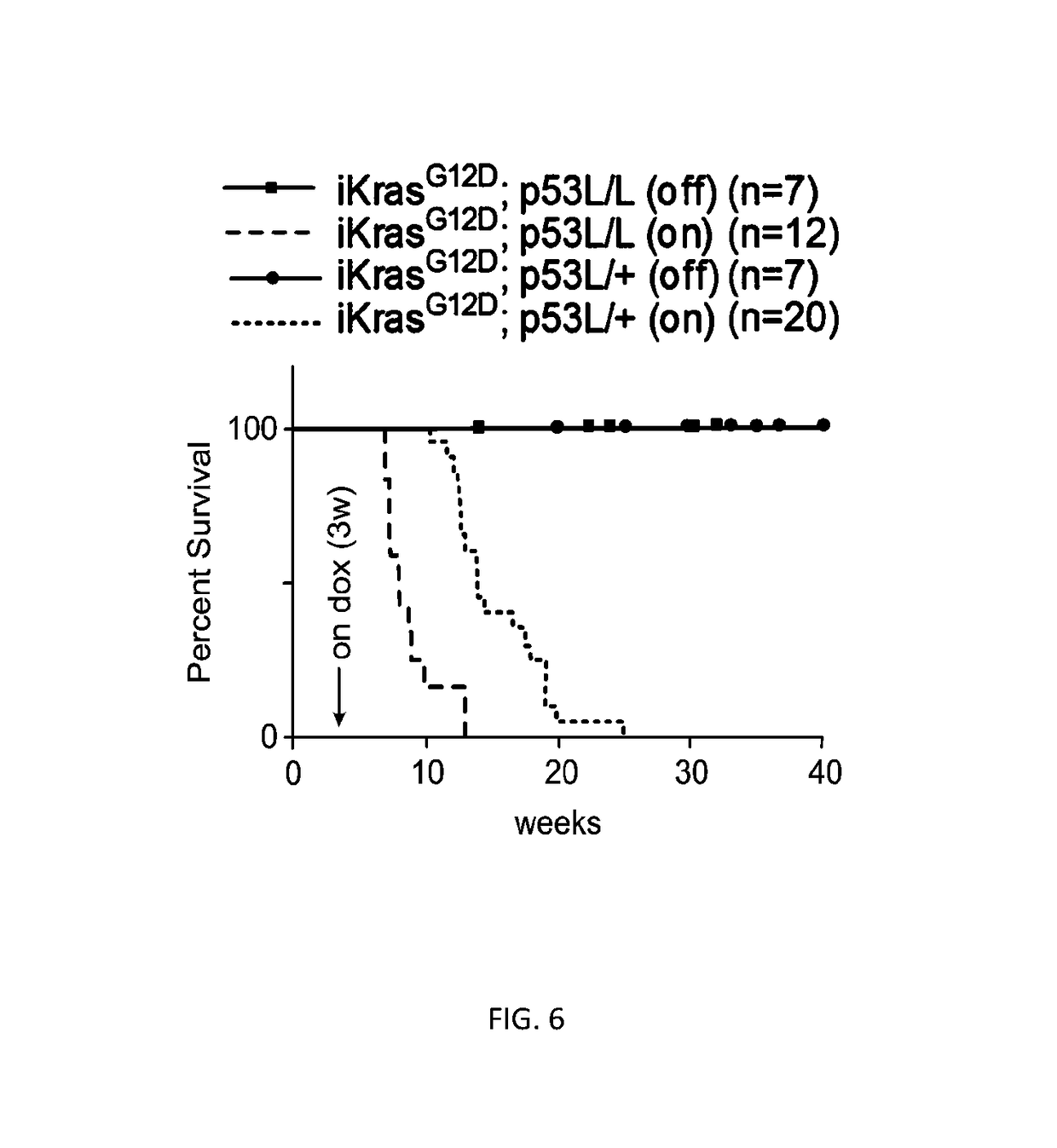Methods for diagnosing and treating oncogenic kras-associated cancer
a technology of oncogenic kras and cancer, applied in the direction of biochemistry apparatus and processes, organic active ingredients, gene material ingredients, etc., can solve the problems of poor response to mek inhibitors and insufficient understanding
- Summary
- Abstract
- Description
- Claims
- Application Information
AI Technical Summary
Benefits of technology
Problems solved by technology
Method used
Image
Examples
example 1
and Methods
[0211]The following are the materials and methods used in the Examples set forth below.
[0212]Generation of Plasmid Construct and Inducible KrasG12D (iKrasG12D) Transgenic Mice
[0213]To generate the tetO_Lox-Stop-Lox-KrasG12D transgene, a fragment containing LoxP-Kozak-ATG-Stop sequence was inserted into the EcoRI / NheI site of pTRE-Tight (Clonetech). A splice acceptor sequence was inserted into the NheI / HindIII site of pTRE-Tight and a Stopper-LoxP sequence was inserted into the HindIII / SalI site to generate pTRE-Tight-LSL. The tetO_LSL fragment was isolated from pTRE-tight-LSL with XhoI / SalI digestion and inserted into the XbaI site of pBS-KS containing the SV40 poly(A) sequence inserted into the BamHI site. A fragment containing mutant murine KrasG12D cDNA (see, Johnson et al. (2001) Nature 410:1111-1116) was inserted into the EcoRV site of pKS-Tight-LSL. TetO_LKrasG12D mice were produced by injecting the construct into FVB / N blastocysts according to a standard protocol (...
example 6
in the Non-Oxidative Arm of the Pentose Phosphate Pathway
[0265]This example demonstrates that KrasG12D promotes ribose biogenesis through the non-oxidative arm of the pentose phosphate pathway (PPP).
[0266]The PPP utilizes glucose to generate the ribose ring of DNA and RNA and to maintain cellular reducing power in the form of NADPH. Metabolomic profiling analysis revealed significant changes in several metabolites from the PPP (FIG. 28). In particular, steady state metabolomic analysis showed that an intermediate unique to the PPP, sedohepulose-7-phosphate (S7P), was significantly reduced upon KrasG12D extinction (FIG. 29). To further elucidate the effect of KrasG12D activity on glucose catabolism through the PPP, U-13C6-glucose was used to trace glucose flux into the PPP. Consistent with the steady state metabolite data, it was observed that KrasG12D maintains glycolysis without affecting the TCA cycle. The flux of U-13C6-glucose into the TCA cycle intermediates, citrate, fumarate ...
example 9
mportant for Tumorigenic Activity of iKras p53L / + PDAC Cells
[0275]As shown in Example 4, above, extinction of iKras led to decreased expression of FASN. Thus, it was next determined whether FASN plays a role in tumorigenesis in PDAC tumor model. iKras p53L / + PDAC were treated with shRNA against FASN or GFP (control). As shown in FIG. 48, FASN shRNA1 and shRNA4, and to some extent shRNAS, caused a marked decrease in FASN expression in PDAC. As shown in FIG. 49, FASN shRNA1 and shRNA4, and to some extent shRNAS, also induced a marked decrease in colony formation. Thus, FASN was determined to play a role in tumorigenic activity of iKras p53L / + PDAC cells.
[0276]Discussion
[0277]In the present Examples, a novel inducible KrasG12D-driven PDAC model provided genetic evidence that oncogenic Kras serves a tumor maintenance role in fully established PDAC. Integrated genomic, biochemical and metabolomic analyses immediately following KrasG12D extinction revealed a prominent perturbation of mult...
PUM
| Property | Measurement | Unit |
|---|---|---|
| time | aaaaa | aaaaa |
| cycle time | aaaaa | aaaaa |
| size | aaaaa | aaaaa |
Abstract
Description
Claims
Application Information
 Login to View More
Login to View More - R&D
- Intellectual Property
- Life Sciences
- Materials
- Tech Scout
- Unparalleled Data Quality
- Higher Quality Content
- 60% Fewer Hallucinations
Browse by: Latest US Patents, China's latest patents, Technical Efficacy Thesaurus, Application Domain, Technology Topic, Popular Technical Reports.
© 2025 PatSnap. All rights reserved.Legal|Privacy policy|Modern Slavery Act Transparency Statement|Sitemap|About US| Contact US: help@patsnap.com



